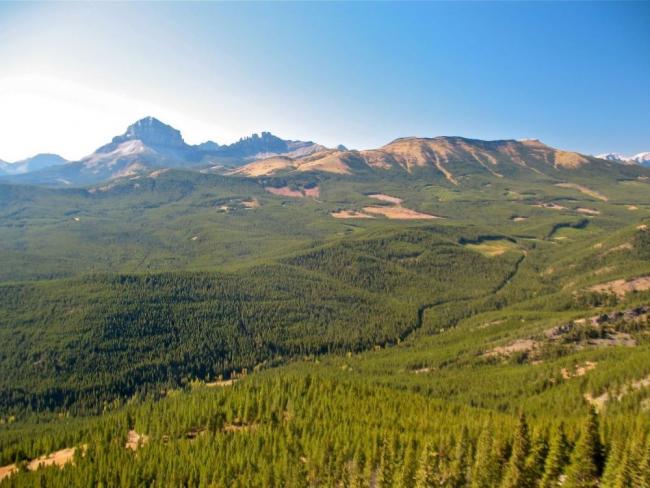Articles Menu

Sept. 20, 2023
Gina Rinehart, Australia’s richest person who made a fortune selling iron ore to China and India, apparently doesn’t take no for answer.
The multi-billionaire right-wing climate change skeptic is back in the Canadian Rockies with a new company to resurrect old plans to develop an open pit metallurgical coal mine. It starts with new requests for drilling deep exploratory wells at Grassy Mountain in the headwaters of the Oldman River.
As a result conservationists and landowners are gearing up for another epic battle to keep coal mining out of the eastern slopes in the Rocky Mountains which serve as a critical watershed for bone-dry Alberta.
“It seemed like the Australian coal miners went away but I don’t think they ever stopped,” the president of the Canadian Parks and Wilderness Society, Katie Morrison, told the Tyee.
“Albertans are very aware about the risks of coal mines, and they don’t want to see them in the eastern slopes. I think there will be one hell of a fight.”
Two years ago, a joint provincial and federal review panel review concluded that Rinehart’s Benga Mining proposal for a giant open pit mine in the Crowsnest Pass was a no-go because it would have “significant adverse environmental effects” on water, wildlife and Indigenous rights.
After that decision Rinehart, who bought Benga Mining from Riverdale Resources for $700 million in 2019, challenged “the fairness” of the ruling in the Alberta Court of Appeal and then the Supreme Court. Both courts denied the appeal.
Although a 2021 provincial order blocked coal mining in some parts of the Rockies in response to sustained public protests over plans by largely Australian developers and the Kenney government to mine 800 square miles of the famous mountain chain, the Grassy Mountain project was not affected by that mandate because it is partially located on an old mining site.
So now Rinehart has returned with a different company called Northback Holdings with offices in Calgary and Coleman in the Crowsnest Pass, a historic coal-mining region.
Although the name might be new, Northback Holdings is pursuing an old mission — to revive the same plan rebuked by regulators and by public protests. The goal is to excavate metallurgical coal from a 15-square-kilometre pit on Grassy Mountain in an already degraded watershed providing water for a million people in part of the province experiencing significant drought.
But Rinehart, whose $38-billion fortune gives her deep pockets, has also hired a new CEO, Mike Young.
The veteran Canadian-born mining executive and geologist managed iron ore and uranium mines in Western Australia where Rinehart established her mining empire.
“Our ambition is to build Riversdale into an integrated resource company which operates a world-class steel-making coal mine that is safe, and supports Crowsnest Pass, Alberta,” Young told the Crowsnest Pass Herald in 2022 before the company changed its name. “We will do this in a way that respects the environment and people, and responsibly build a better, lasting legacy.”
To that end Northback Holdings has now applied to the Alberta Energy Regulator for a license to drill 46 deep wells on Grassy Mountain in the Crowsnest Pass on private and Crown land as part of an extensive coal exploration program proposed for next year. The wells will bore up to 500 metres underground.
“This deep drilling will enable Northback to better understand the full depth of the Grassy Mountain deposit, to obtain raw coal samples/acid rock drainage (ARD) samples, and structurally model the complexity of the coal seams,” explained the company in its application.
In 2022 Premier Danielle Smith said that she would be in favour of open pit coal mining on already disturbed land if local Albertans approved the project in a referendum.
During public hearings on Rinehart’s original Benga Mine proposal, the Livingstone Landowners Group hired six prominent scientists, including Alberta’s respected land use ecologist Brad Stelfox, to model the impacts of proposed projects on water security in an arid county.
The group’s comprehensive study on cumulative impacts, which the Alberta government has not done, found even limited coking coal mining would create intractable problems with water quality and quantity, including selenium contamination. Rapidly accelerating climate change only compounds the risks.
In a recent chat with The Australian Financial Review Rinehart marked her three-decade helm at Hancock Prospecting by noting she wanted to continue to invest in iron ore, copper, lithium, gold and rare earths minerals while continuing to battle “greenies and fellow travellers.”
“Unfortunately, there are many anti-mining people and fellow travellers who fail to realise the vital nature of what our industry provides,” she said.
“There are some people who would be happy to see our industry shut down, but would they be happy to give up their phones, homes, iPads, cars, electricity, hospitals, bridges, trains, buses, planes and more?”
The Alberta government has declared its intention to become “a preferred international producer and supplier of minerals and mineral products such as lithium, uranium, vanadium, rare earth elements, potash, and diamonds.” That means more mining throughout the province.
Bill Trafford, a landowner who served on the Coal Policy Committee that recommended any plans for coal mining cease before land use plans had been completed in 2021, doesn’t think Albertans will take kindly to a renewed push to mine the Rockies for steel making coal.
“I think Albertans will react hugely and negatively to any coal mining plans. That’s what they did during our expensive public engagement process. And nothing has changed except for one thing: Calgary is now under water restrictions.”
In the very watershed where Northback is proposing open-pit mining, the municipal district of Pincher Creek is unable to pump water from the Oldman River Reservoir due to drought conditions.
As a result, many communities now depend on trucked-in water.
The reservoir looks like a dystopian moonscape composed of drying and cracking mud with barely a trickle of water running through it.
[Top photo: https://thetyee.ca/Analysis/2023/09/20/Australia-Coal-Miners-Gina-Rineha...